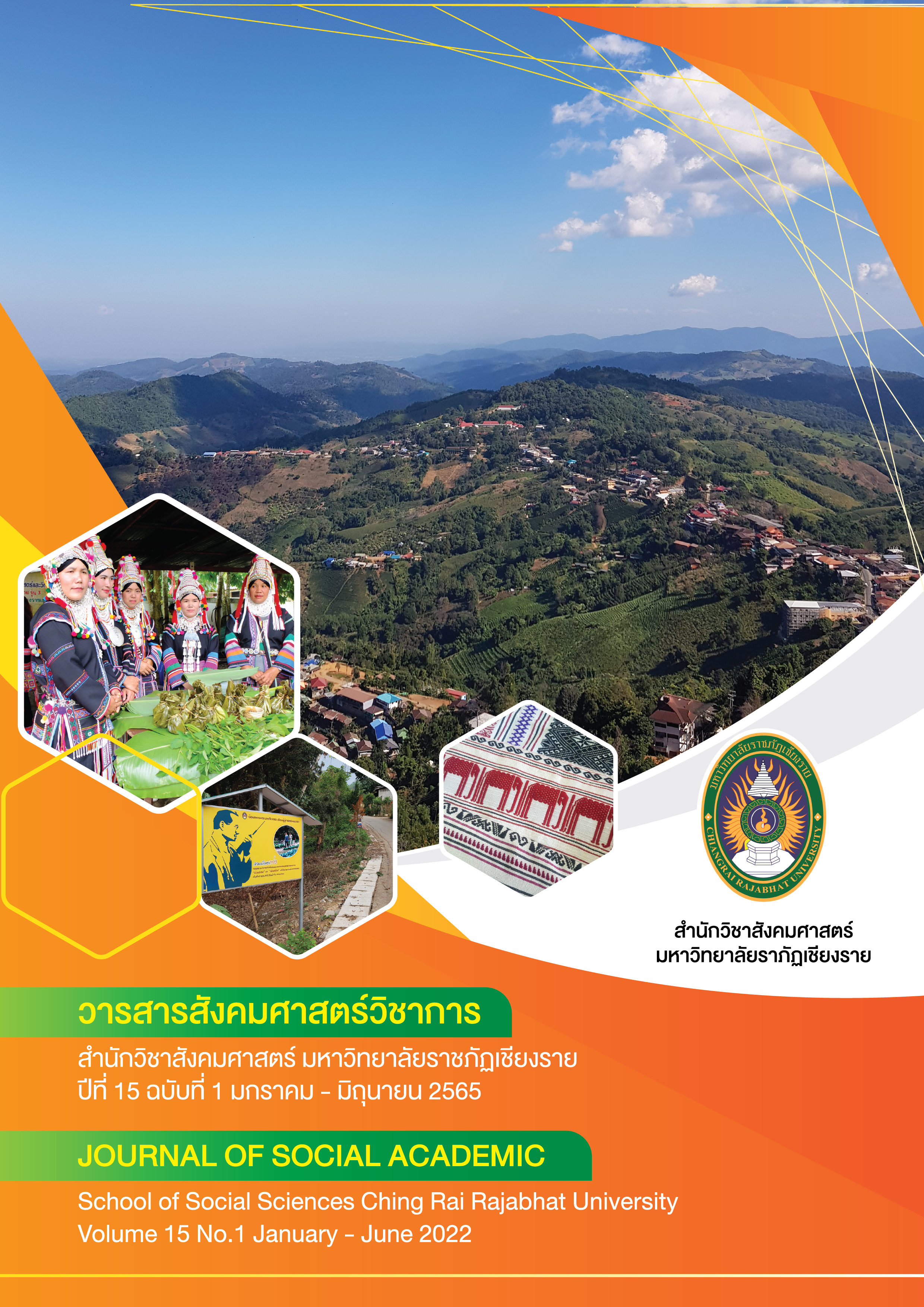A study of dyeing cotton yarn with natural colors from Eupatorium odoratum L.
Main Article Content
Abstract
A study of natural dyeing of cotton yarn from sap tiger leaves aimed at 1. A study of dyeing cotton yarn with natural dyes from leaves of Eupatorium odoratum L. 2. A study of the properties of cotton yarn dyeing fabrics with natural dyes from the leaves of the Eupatorium odoratum L. The study found Boiling process to clean 700 g of cotton fibers, use clean water 7.5 liters, 2.5 grams of caustic soda, 5 grams of soda-ass and 5 grams of soap, boiled at boiling point for 30 minutes. Natural dyeing with tiger sage leaves revealed that 500 g of fresh tiger sap leaves, 10 liters of water and 30 g of table salt were used for dyeing at a temperature of more than 80 degrees Celsius for 60 minutes. Four types of modifiers or coloring agents were used, namely 1) color support, color support ratio of 3 g. per 1 liter of water gives light green dye 2) Alum, alum ratio of 10 grams per 3 liters of water gives a yellow-green dye 3) Iron rust, 3 grams of iron rust ratio per 1 liter of water gives a grayish-green dye 4) Lime, the ratio of lime 3 grams per water 3 liters for a green dye Washing off excess paint, ratio of dishwashing liquid 10 cc per 10 liters of water Properties of cotton yarn after dyeing Color fastness to sweat, alkaline conditions. Alum's modulation is level 4 good, and all mods are not resistant to acidic sweat. Color fastness to water was found that Modance Lime was at level 5 the best. Color fastness to washing found that Modance Joon paint, alum and lime were at level 4-5, good to best. The color fastness to abrasion in dry condition was found that all modulations were at level 4-5, good to best. The color fastness to abrasion in wet condition was found that the paint's modulus was at level 3, the color fastness was moderate, it was found that the paint's modacity and lime was at the level 4 was good.
Keywords : Staining, Cotton yarn, Natural dye, Eupatorium odoratum L.
Article Details

This work is licensed under a Creative Commons Attribution-NonCommercial-NoDerivatives 4.0 International License.
รายละเอียดของลิขสิทธ์
References
Areerat Phosuwan. (2015). “Dyeing hand-woven cotton with natural colors”. Department of Science Service Ministry of Higher Edocation, Science, Research and Innovation, 63(19): 25-27 (in Thai).
Jitsopin Pengboou and Suthasini Bureekhampun. (2021). “Study and product development of the natural tied-dye fabric group of BanYang district, Surat Thani province”. AJNU Art and Architecture Journal Naresuan University, 12(1): 225-240 (in Thai).
Manus Chanpoung, Wiyanee Dangkong, Parichat Koonkleang, Supaporn Thanakwang, Natkamon Buaban and Aekkaphob Ninlaphat. (2021). “Development of Tie-dyed from Natural Dye Extracted from Teak Leaves at Ban Mae Phuak, Huai Rai Subdistrict, Den Chai District, Phrae Province”. Journal of Community Development and Life Quality, 12(1): 225-240 (in Thai).
Mek Chanprayoou. (2005). Local vegetables. Bangkok: June Publishing. (in Thai).
Nantawan Bunyaprapat and Oranuch Chokchaicharoenporn. (2000). Folk herbs. Bangkok: People. (in Thai).
Norathep Phothipeng, Srikanjana jatuphatwarodom, Rattanaphol Mongkholrattanasit. (2020). “ColorFastness and Physical Properties of Cotton FabricinSilk Screen Printing with Red Soil”. UTK Research journal, 14(2): 91-103 (in Thai).
Pawinrat Saetang. (2013). “Values Addedon Natural DyedWoven Fabric by NaturalDyeingProcessUsing an Auxiliary Agent from Chae Son Hot Spring, Mueang Pan District,Lampang Province”. Journal of Community Development and Life Quality, 1(1): 9-22 (in Thai).
Prapakorn Sukonthamanee. (2017). “Color of Flora”. Silpakorn University Journal, 37(3): 183-202 (in Thai).
Songphan Wannamas. (2007). Transferring Lanna Local Wisdom to the World. Chiang rai : Lanna. Textile Center Chiang Rai Rajabhat University (in Thai).
Wichachan Wanphonthong. (2005). “natural dyeing”. Department of Science Service Ministry of Higher Education, Science, Research and Innovation, 53(168): 35-37 (in Thai).
Veerasak Seerarat and Natsima Tokhun. (2020). “Value Added of Sacred Lotus with Natural Tie-dyed Cotton Wisdom”. Journal of Community Development and Life Quality, 9(2): 205-212 (in Thai).

